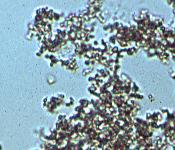"Amorphous" crystals appear as aggregates of finely granular material without any defining
shape at the light microscopic level.
 Amorphous urates (Na, K, Mg, or Ca salts) tend to form in acidic urine, and may have a
yellow or yellow-brown color.
Amorphous urates (Na, K, Mg, or Ca salts) tend to form in acidic urine, and may have a
yellow or yellow-brown color.
Amorphous phosphates are similar in general appearance, but tend to form in alkaline urine and lack color. Calcium oxalate dihydrate crystals sometimes also can present as "amorphous" when the individual crystals are very small. Examination at higher magnification will reveal the typical "envelope" appearance. Xanthine crystals are usually in the form of "amorphous" crystals. These crystals occur in Dalmations on allopurinol therapy for urate urolithiasis. Generally, no specific clinical interpretation can be made based on the finding of amorphous crystals. Small amorphous crystals can be confused with bacterial cocci in some cases, but can be distinguished by Gram-staining. |
Last updated: January 15, 1996